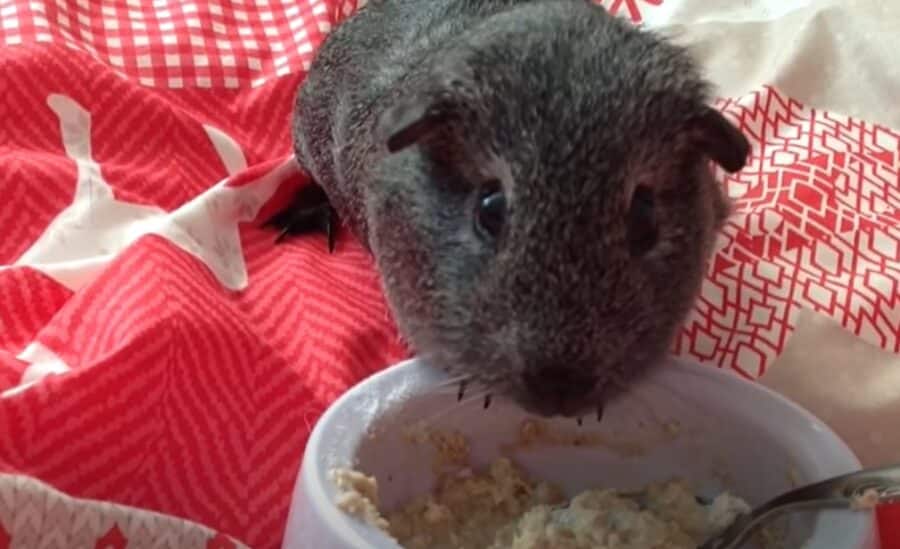Is your guinea pig looking too big or too skinny? Are you wondering How Can I Help My Guinea Pig Gain or Lose Weight?
Do you need to figure out if this weight gain or loss can be reversed or restored to a healthy level?
In this article, we’ll discuss the topic of guinea pig weight gain and weight loss.
How Can I Help My Guinea Pig Gain or Lose Weight?
Seek medical help if your guinea pig is gaining or losing more than 2 ounces per week. Weigh your guinea pig and look to substitute the hay and pellet types and add fresh foods in controlled portions.

Why Does My Guinea Pig Lose Weight?
Guinea pigs are popular for their cute, plump appearance. Seeing your guinea pig losing weight could be frustrating, alarming and stressful for you. It’s important to find out the reasons why this is happening. They may include:
- tooth pain
- overgrown teeth
- sensitive GI tract
- UTI (urinary tract infection)
- bloating
- lack of vitamin C
If your guinea pig’s teeth haven’t been worn down well with healthy doses of hay, then your cavy might be uncomfortable and could stop eating or eat less.
Vitamin C deficient guinea pigs weaken and may not wish to eat. Instead of trying to diagnose the problem yourself, seek out professional help from a vet if you notice more than 2 ounces or 50 grams of weight loss in a week.
How Much Should My Guinea Pig Weigh?
Your guinea pig should step on a scale and show you the truth. You can use a kitchen scale and set the value to grams to compare to our example. An average adult guinea pig weighs:
- 700–900 grams as a female
- 900–1200 grams as a male
Before you begin to get concerned about your guinea pig falling outside of this range, slight variances are normal and it’s best to monitor changes week to week.
Note:
Did you guinea pig lose or gain 50 grams this week? If so, please visit the vet.
How Do I Help My Guinea Pig Gain Weight?
Your guinea pig or cavy may need your help and support to add more food or supplements to its diet. Start slowly and listen to the recommendation of your vet that may have been consulted with if the weight loss is noticeable or concerning.
They will likely tell you some of the following recommendations:
- Be careful with new foods.
- Don’t expect the weight to be gained quickly.
New Foods
Your guinea pig’s GI tract is sensitive and needs portion control. Start with new foods gradually and offer small portions of food outside of their staple pellets and hay.
Each new food may throw their gut bacteria off and needs time to adjust. Diarrhea or bloating could result.
Slow Gains
Rapid weight gain through a heavy meal plan will force the subject and create digestive issues for your guinea pig.
If you notice weight gains over 2 ounces or 50 grams a week, then your guinea pig is overdoing it. Keep serving hay in endless amounts, but be weary of adding more pellets or fresh foods.
Which Foods Will Help My Guinea Pig Gain Weight?
You will be able to help you guinea pig gain weight if you make a few dietary changes. Start with the following:
- Alfalfa hay
- Readigrass hay
- Oat hay
- More Vegetables and Pellets
- Oats
- Sunflower seed (shelled))
Substitute The Hay
Certain types of hay are not as common for guinea pigs to eat due to many factors including their calorie content being too high.
Alfalfa hay is higher in protein and calories, but usually not recommended for healthy guinea pigs. Timothy hay, orchard, bluegrass and meadow are used more often.
Alfalfa hay is advised for younger or malnourished guinea pigs along with pregnant mothers. Readigrass is also rich in fiber and protein. Oat hay is recommended with alfalfa to reduce the amount of calcium from the latter.
Vegetables
Vegetables supply vitamin C which guinea pigs cannot produce or synthesize or their own. They also support healthy weight gain. Offer the following vegetables about the size of your finger to 1 cup a day:
- Cabbage
- Dandelion greens
- Broccoli
- Parsley
- Kale
- Cauliflower
- Chickweed
- Tomato
- Bell peppers
Pellets
Pellets should be formulated to suit the needs of guinea pigs. A 1/8 cup per day portion is commonly offered.
Try not to exceed what is recommended on the packaging label. You can also add oats or shelled sunflower seeds for extra weight gaining, but do so gradually.
We wrote a helpful guide of what and and where to feed your guinea pig that we think would also help you.
How Can I Tell If My Guinea Pig Is Overweight?
Weigh your guinea pig. Make sure the scale reads close to 700–900 grams for females and 900–1200 grams for males. Feel for the ribs. Overweight guinea pigs make it hard for you to get any sense of where their ribs are.
Your guinea pig should have a narrower chest than its hind end. It’s hard to even see the feet of your overweight guinea pig if you’re looking from the top down.
Conclusion
Sufficient playtime and exercise is needed for all guinea pigs. They can get this through toys, wheels, ramps or exploring for hidden meals in their enclosure. A light guinea pig could be in pain, ill or uncomfortable.
If the weight loss continues from 1 week to the next, seek a diagnosis. Offer plenty of hay and add more fresh foods along with oats and shelled sunflower seeds.
Know how to feel your guinea pig for the ribs and check to see their feet when looking from above.
We hope you have a guinea pig who has returned to a healthy weight soon, but take your time and focus on making progress gradually.

